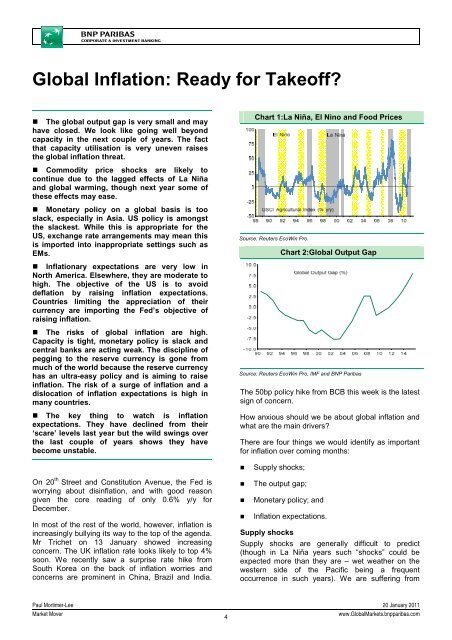Market Economics | Interest Rate Strategy - BNP PARIBAS ...
Market Economics | Interest Rate Strategy - BNP PARIBAS ...
Market Economics | Interest Rate Strategy - BNP PARIBAS ...
You also want an ePaper? Increase the reach of your titles
YUMPU automatically turns print PDFs into web optimized ePapers that Google loves.
Global Inflation: Ready for Takeoff?<br />
• The global output gap is very small and may<br />
have closed. We look like going well beyond<br />
capacity in the next couple of years. The fact<br />
that capacity utilisation is very uneven raises<br />
the global inflation threat.<br />
Chart 1:La Niña, El Nino and Food Prices<br />
• Commodity price shocks are likely to<br />
continue due to the lagged effects of La Niña<br />
and global warming, though next year some of<br />
these effects may ease.<br />
• Monetary policy on a global basis is too<br />
slack, especially in Asia. US policy is amongst<br />
the slackest. While this is appropriate for the<br />
US, exchange rate arrangements may mean this<br />
is imported into inappropriate settings such as<br />
EMs.<br />
Source: Reuters EcoWin Pro.<br />
Chart 2:Global Output Gap<br />
• Inflationary expectations are very low in<br />
North America. Elsewhere, they are moderate to<br />
high. The objective of the US is to avoid<br />
deflation by raising inflation expectations.<br />
Countries limiting the appreciation of their<br />
currency are importing the Fed’s objective of<br />
raising inflation.<br />
• The risks of global inflation are high.<br />
Capacity is tight, monetary policy is slack and<br />
central banks are acting weak. The discipline of<br />
pegging to the reserve currency is gone from<br />
much of the world because the reserve currency<br />
has an ultra-easy policy and is aiming to raise<br />
inflation. The risk of a surge of inflation and a<br />
dislocation of inflation expectations is high in<br />
many countries.<br />
• The key thing to watch is inflation<br />
expectations. They have declined from their<br />
‘scare’ levels last year but the wild swings over<br />
the last couple of years shows they have<br />
become unstable.<br />
Source: Reuters EcoWin Pro, IMF and <strong>BNP</strong> Paribas<br />
The 50bp policy hike from BCB this week is the latest<br />
sign of concern.<br />
How anxious should we be about global inflation and<br />
what are the main drivers?<br />
There are four things we would identify as important<br />
for inflation over coming months:<br />
• Supply shocks;<br />
On 20 th Street and Constitution Avenue, the Fed is<br />
worrying about disinflation, and with good reason<br />
given the core reading of only 0.6% y/y for<br />
December.<br />
In most of the rest of the world, however, inflation is<br />
increasingly bullying its way to the top of the agenda.<br />
Mr Trichet on 13 January showed increasing<br />
concern. The UK inflation rate looks likely to top 4%<br />
soon. We recently saw a surprise rate hike from<br />
South Korea on the back of inflation worries and<br />
concerns are prominent in China, Brazil and India.<br />
• The output gap;<br />
• Monetary policy; and<br />
• Inflation expectations.<br />
Supply shocks<br />
Supply shocks are generally difficult to predict<br />
(though in La Niña years such “shocks” could be<br />
expected more than they are – wet weather on the<br />
western side of the Pacific being a frequent<br />
occurrence in such years). We are suffering from<br />
Paul Mortimer-Lee 20 January 2011<br />
<strong>Market</strong> Mover<br />
4<br />
www.Global<strong>Market</strong>s.bnpparibas.com

















